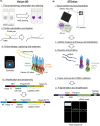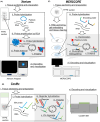Spatial omics technologies for understanding molecular status associated with cancer progression
- PMID: 39042942
- PMCID: PMC11447966
- DOI: 10.1111/cas.16283
Spatial omics technologies for understanding molecular status associated with cancer progression
Abstract
Cancer cells are generally exposed to numerous extrinsic stimulations in the tumor microenvironment. In this environment, cancer cells change their expression profiles to fight against circumstantial stresses, allowing their progression in the challenging tissue space. Technological advancements of spatial omics have had substantial influence on cancer genomics. This technical progress, especially that occurring in the spatial transcriptome, has been drastic and rapid. Here, we describe the latest spatial analytical technologies that have allowed omics feature characterization to retain their spatial and histopathological information in cancer tissues. Several spatial omics platforms have been launched, and the latest platforms finally attained single-cell level or even higher subcellular level resolution. We discuss several key papers elucidating the initial utility of the spatial analysis. In fact, spatial transcriptome analyses reveal comprehensive omics characteristics not only in cancer cells but also their surrounding cells, such as tumor infiltrating immune cells and cancer-associated fibroblasts. We also introduce several spatial omics platforms. We describe our own attempts to investigate molecular events associated with cancer progression. Furthermore, we discuss the next challenges in analyzing the multiomics status of cells, including their morphology and location. These novel technologies, in conjunction with spatial transcriptome analysis and, more importantly, with histopathology, will elucidate even novel key aspects of the intratumor heterogeneity of cancers. Such enhanced knowledge is expected to open a new path for overcoming therapeutic resistance and eventually to precisely stratify patients.
Keywords: cancer progression; multiomics; single‐cell resolution; spatial transcriptome; tumor microenvironment.
© 2024 The Author(s). Cancer Science published by John Wiley & Sons Australia, Ltd on behalf of Japanese Cancer Association.
Conflict of interest statement
The authors declare no conflict of interest.
Figures



Similar articles
-
Single-Cell Multi-Omics: Insights into Therapeutic Innovations to Advance Treatment in Cancer.Int J Mol Sci. 2025 Mar 9;26(6):2447. doi: 10.3390/ijms26062447. Int J Mol Sci. 2025. PMID: 40141092 Free PMC article. Review.
-
Conserved spatial subtypes and cellular neighborhoods of cancer-associated fibroblasts revealed by single-cell spatial multi-omics.Cancer Cell. 2025 May 12;43(5):905-924.e6. doi: 10.1016/j.ccell.2025.03.004. Epub 2025 Mar 27. Cancer Cell. 2025. PMID: 40154487
-
Single-Cell RNA Sequencing with Spatial Transcriptomics of Cancer Tissues.Int J Mol Sci. 2022 Mar 11;23(6):3042. doi: 10.3390/ijms23063042. Int J Mol Sci. 2022. PMID: 35328458 Free PMC article. Review.
-
The burgeoning spatial multi-omics in human gastrointestinal cancers.PeerJ. 2024 Sep 13;12:e17860. doi: 10.7717/peerj.17860. eCollection 2024. PeerJ. 2024. PMID: 39285924 Free PMC article. Review.
-
Spatial multi-omics analyses of the tumor immune microenvironment.J Biomed Sci. 2022 Nov 14;29(1):96. doi: 10.1186/s12929-022-00879-y. J Biomed Sci. 2022. PMID: 36376874 Free PMC article. Review.
Cited by
-
Defining Keypoints to Align H&E Images and Xenium DAPI-Stained Images Automatically.Cells. 2025 Jun 30;14(13):1000. doi: 10.3390/cells14131000. Cells. 2025. PMID: 40643521 Free PMC article.
-
The immunosuppressive role of VSIG4 in colorectal cancer and its interaction with the tumor microenvironment.Discov Oncol. 2025 May 3;16(1):664. doi: 10.1007/s12672-025-02411-8. Discov Oncol. 2025. PMID: 40317372 Free PMC article.
References
Publication types
MeSH terms
Grants and funding
LinkOut - more resources
Full Text Sources
Medical

